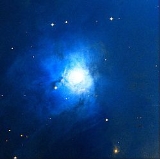
NGC 2023
Encyclopedia
The reflection nebula
NGC 2023 is in the constellation Orion
. It is one of the brightest sources of fluorescent molecular hydrogen, and at 4 light-year
s wide it is one of the largest in the sky. It is powered by the B star (B1.5) HD 37903, the most luminous member of a cluster of young stellar objects illuminating the front surface of the Lynds 1630 molecular cloud (Barnard 33) in Orion B.
NGC 2023 forms a cavity in the surface of the cloud, some 450 parsecs from Earth. It produces a bright visual reflection nebula and an ultraviolet-excited photodissociation region
. It is about a third of a degree
from the Horsehead Nebula
and is often included (but not indicated) in images of that object.
Reflection nebula
In Astronomy, reflection nebulae are clouds of dust which are simply reflecting the light of a nearby star or stars. The energy from the nearby star, or stars, is insufficient to ionize the gas of the nebula to create an emission nebula, but is enough to give sufficient scattering to make the dust...
NGC 2023 is in the constellation Orion
Orion (constellation)
Orion, often referred to as The Hunter, is a prominent constellation located on the celestial equator and visible throughout the world. It is one of the most conspicuous, and most recognizable constellations in the night sky...
. It is one of the brightest sources of fluorescent molecular hydrogen, and at 4 light-year
Light-year
A light-year, also light year or lightyear is a unit of length, equal to just under 10 trillion kilometres...
s wide it is one of the largest in the sky. It is powered by the B star (B1.5) HD 37903, the most luminous member of a cluster of young stellar objects illuminating the front surface of the Lynds 1630 molecular cloud (Barnard 33) in Orion B.
NGC 2023 forms a cavity in the surface of the cloud, some 450 parsecs from Earth. It produces a bright visual reflection nebula and an ultraviolet-excited photodissociation region
Photodissociation region
Photodissociation regions are predominantly neutral regions of the interstellar medium in which far ultraviolet photons strongly influence the gas chemistry and act as the most important source of heat...
. It is about a third of a degree
Degree (angle)
A degree , usually denoted by ° , is a measurement of plane angle, representing 1⁄360 of a full rotation; one degree is equivalent to π/180 radians...
from the Horsehead Nebula
Horsehead Nebula
The Horsehead Nebula is a dark nebula in the constellation Orion. The nebula is located just to the south of the star Alnitak, which is farthest east on Orion's Belt, and is part of the much larger Orion Molecular Cloud Complex. The Horsehead Nebula is approximately 1500 light years from Earth...
and is often included (but not indicated) in images of that object.

